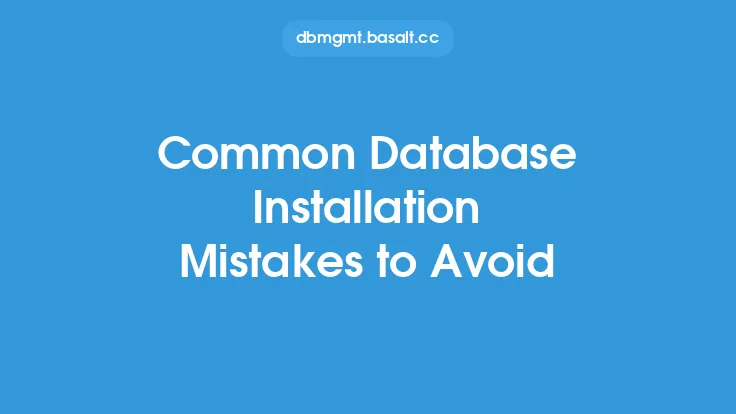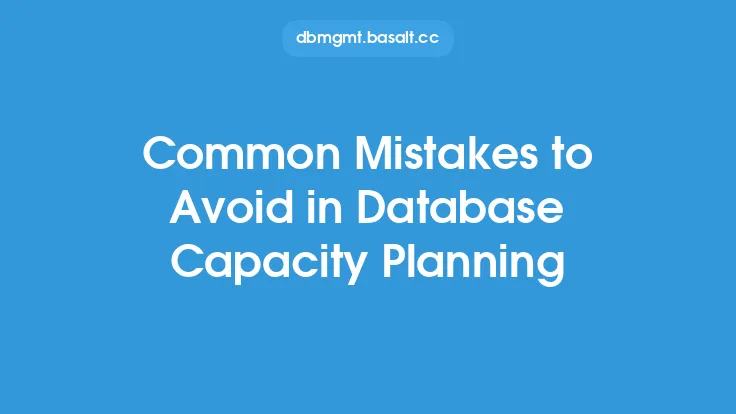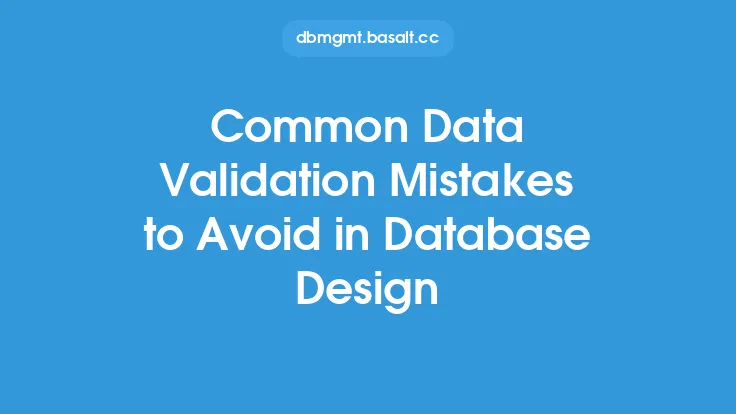When designing and implementing database authentication systems, there are several common mistakes that can compromise the security and integrity of the data. These mistakes can be costly, both in terms of financial losses and damage to an organization's reputation. In this article, we will explore some of the most common database authentication mistakes to avoid, and provide guidance on how to implement secure authentication mechanisms.
Introduction to Database Authentication Mistakes
Database authentication is the process of verifying the identity of users, applications, or services that attempt to access a database. It is a critical component of database security, as it helps to prevent unauthorized access to sensitive data. However, if not implemented correctly, database authentication can be vulnerable to various types of attacks, including password cracking, phishing, and SQL injection. To avoid these types of attacks, it is essential to be aware of the common mistakes that can compromise database authentication.
Weak Passwords and Password Management
One of the most common database authentication mistakes is the use of weak passwords. Weak passwords are easy to guess or crack, and can be compromised using various techniques, such as dictionary attacks or brute-force attacks. To avoid this mistake, it is essential to implement strong password policies, including password length, complexity, and rotation requirements. Additionally, passwords should be stored securely, using techniques such as hashing and salting, to prevent them from being compromised in the event of a data breach.
Insufficient Authentication Protocols
Another common mistake is the use of insufficient authentication protocols. Authentication protocols, such as SQL Server Authentication or Oracle Authentication, provide a mechanism for verifying the identity of users and applications. However, if these protocols are not implemented correctly, they can be vulnerable to various types of attacks. For example, if a protocol uses a weak encryption algorithm, it can be compromised using techniques such as man-in-the-middle attacks. To avoid this mistake, it is essential to use secure authentication protocols, such as Kerberos or SSL/TLS, and to configure them correctly.
Inadequate User Privilege Management
Inadequate user privilege management is another common database authentication mistake. User privileges determine the level of access that a user or application has to a database, and if not managed correctly, can provide an attacker with excessive privileges. To avoid this mistake, it is essential to implement a least privilege model, where users and applications are granted only the privileges that are necessary to perform their tasks. Additionally, user privileges should be regularly reviewed and updated to ensure that they are still necessary and appropriate.
Lack of Auditing and Logging
A lack of auditing and logging is another common database authentication mistake. Auditing and logging provide a mechanism for tracking and monitoring database activity, and can help to detect and respond to security incidents. However, if auditing and logging are not implemented correctly, they can be ineffective in detecting and responding to security incidents. To avoid this mistake, it is essential to implement comprehensive auditing and logging mechanisms, including logging of authentication attempts, database queries, and system changes.
Insecure Network Communications
Insecure network communications are another common database authentication mistake. Network communications provide a mechanism for transmitting data between a database and its clients, and if not secured correctly, can be vulnerable to various types of attacks, such as eavesdropping or tampering. To avoid this mistake, it is essential to use secure network communication protocols, such as SSL/TLS or IPsec, and to configure them correctly.
Failure to Implement Account Lockout Policies
Failure to implement account lockout policies is another common database authentication mistake. Account lockout policies provide a mechanism for locking out a user or application after a specified number of failed authentication attempts, and can help to prevent brute-force attacks. However, if account lockout policies are not implemented correctly, they can be ineffective in preventing brute-force attacks. To avoid this mistake, it is essential to implement account lockout policies, including specifying the number of failed authentication attempts that will trigger a lockout, and the duration of the lockout.
Inadequate Database Security Configuration
Inadequate database security configuration is another common database authentication mistake. Database security configuration provides a mechanism for configuring database security settings, such as authentication protocols, user privileges, and auditing and logging. However, if database security configuration is not implemented correctly, it can be vulnerable to various types of attacks. To avoid this mistake, it is essential to implement a secure database security configuration, including configuring authentication protocols, user privileges, and auditing and logging.
Conclusion
In conclusion, database authentication is a critical component of database security, and if not implemented correctly, can be vulnerable to various types of attacks. By avoiding common mistakes, such as weak passwords, insufficient authentication protocols, inadequate user privilege management, lack of auditing and logging, insecure network communications, failure to implement account lockout policies, and inadequate database security configuration, organizations can help to ensure the security and integrity of their databases. Additionally, by implementing secure authentication mechanisms, organizations can help to prevent unauthorized access to sensitive data, and protect themselves against various types of attacks.





